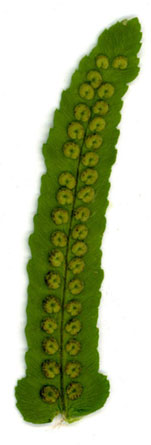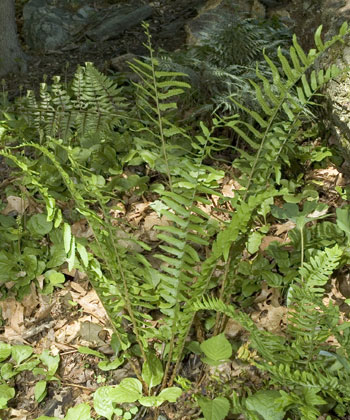| Dryopteris tokyoensis | ||
|
Etymology
Tokyoensis is the Latinization of the city in Japan, Tokyo.
Description
Rhizome: short, thick, erect, also branching infrequently, scaly.
Frond: 90 cm high by 20 cm wide, deciduous, monomorphic, blade/stipe ratio: 6:1. Stipe: grooved, green to purple, adjacent fronds exhibiting a variety of shades, scales lanceolate to long-ovate, abruptly acuminate, to 1.5 cm, membranous, brown, often darker in basal portion, vascular bundles: 3-7 in a c-shaped pattern. Blade: 1-pinnate, but in some specimens the pinnae pass over the line from lobed to pinnatifid, oblanceolate, widest above the middle, herbaceous to somewhat leathery, scales on rachis lanceolate to linear. Pinnae: 25 to 35 pair, shallowly lobed to pinnatifid, the lowest pair much reduced; the proximal lobe enlarged, ear-like; veins simple, immersed on top surface. Sori: round, 1 per lobe of the pinna, medial, indusium: reniform, at a sinus, sporangia: brownish. Culture
Habitat: sunny or half-shaded wetlands.
Distribution: China, Japan, Korea.
Hardy to -25�C, USDA Zone 5.
Distinctive Characteristics
Among the slenderest, most upright�of fronds, the blade stipe ratio also distinctive, and the auricled pinnae.
Synonyms
Nephrodium tokyoense Matsum. ex Makino Aspidium transitorium Christ |
|
|

Dryopteris tokyoensis. Fertile pinnae are confined to the top third of larger fronds. Late June; the sporangia are beginning to expand beyond the indusia, but there is some time to go before maturation. �Scan: Tom Stuart |

Dryopteris tokyoensis. Veins free, forking. The veins are depressed, embossed�into the pinna, and the shadow of the sori is visible through the lamina on the left side. �Photo: Tom Stuart |

Dryopteris tokyoensis. �Illustration from The Cultivated Species of the Fern Genus Dryopteris in the United States, Barbara Joe Hoshizaki and Kenneth A. Wilson, American Fern Journal, 89, 1, (1999), with permission. |
